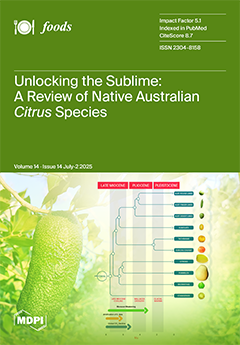Anthocyanins are important phenolic compounds in grape skins, affecting the color, oxidation resistance, and aging ability of red wine. In recent years, global warming has had a negative effect on anthocyanin biosynthesis in grape berries. Ethylene serves as a crucial phytohormone regulating the
[...] Read more.
Anthocyanins are important phenolic compounds in grape skins, affecting the color, oxidation resistance, and aging ability of red wine. In recent years, global warming has had a negative effect on anthocyanin biosynthesis in grape berries. Ethylene serves as a crucial phytohormone regulating the development and ripening processes of fruit; however, the specific molecular mechanism and the regulatory network between ethylene signaling and the anthocyanin biosynthesis pathway remain incompletely understood. In this study, 400 mg/L ethephon (ETH) solution was sprayed onto the surface of grape berries at the lag phase (EL-34), and the changes in anthocyanin-related genes and metabolites were explored through transcriptomic and metabolomic analysis. The results showed that ETH treatment increased Brix and pH in mature berries. In total, 35 individual anthocyanins were detected, in which 21 individual anthocyanins were enhanced by ETH treatment. However, the anthocyanin profile was not affected by exogenous ethylene. Transcriptomics analysis showed that there were a total of 825 and 1399 differentially expressed genes (DEGs) 12 h and 24 h after treatment. Moreover, key structural genes in the anthocyanin synthesis pathway were strongly induced, including
VvPAL,
VvCHS,
VvF3H,
VvF3′5′H,
VvDFR and
VvUFGT. At the maturity stage (EL-38), the expression levels of these genes were still higher in EHT-treated berries than in the control. ETH treatment also influenced the expression of genes related to hormone biosynthesis and signal transduction. The ethylene biosynthesis gene (
VvACO), ethylene receptor genes (
VvETR2,
VvERS1 and
VvEIN4), ABA biosynthesis gene (
VvNCED2), and ABA receptor gene (
VvPYL4) were up-regulated by ETH treatment, while the auxin biosynthesis gene (
VvTAA3) and seven genes of the auxin-responsive protein were inhibited by exogenous ethylene. Meanwhile, ETH treatment promoted the expression of the sugar transporter gene (
VvEDL16) and two sucrose synthase genes (
VvSUS2 and
VvSUS6). In EHT-treated berries, 19 MYB and 23 ERF genes were expressed differently compared with the control (
p < 0.05). This study provides the theoretical foundation and technical support for the regulation of anthocyanin synthesis in non-climacteric fruit.
Full article






